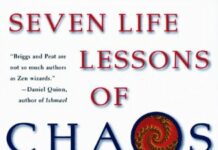
Ebook Info
- Published: 1990
- Number of pages: 224 pages
- Format: PDF
- File Size: 17.36 MB
- Authors: John Briggs
Description
Until recently, such phenomena as the volatility of weather systems, the fluctuation of the shock market, or the random firing of neurons in the brain were considered too “noisy” and complex to be probed by science. But now, with the aid of high-speed computers, scientists have been able to penetrate a reality that is changing the way we perceive the universe. Their findings — the basis for chaos theory — represent one of the most exciting scientific pursuits of our time. No better introduction to this find could be found than John Briggs and F. David Peat’s Turbulent Mirror. Together, they explore the many faces of chaos and reveal how its law direct most of the processes of everyday life and how it appears that everything in the universe is interconnected — discovering an “emerging science of wholeness.”Turbulent Mirror introduces us to the scientists involved in study this endlessly strange field; to the theories that are turning our perception of the world on its head; and to the discoveries in mathematics, biology, and physics that are heralding a revolution more profound than the one responsible for producing the atomic bomb. With practical applications ranging from the control of traffic flow and the development of artifical intelligence to the treatment of heart attacks and schizophrenia, chaos promises to be an increasingly rewarding area of inquiry — of interest to everyone.
User’s Reviews
Editorial Reviews: About the Author John Briggs, Ph.D., is a professor of English and the journalism coordinator at Western Connecticut State University. He lives in Danbury, Connecticut. F. David Peat holds a Ph.D. in physics from the University of Liverpool and has written dozens of books on art, science, and spirituality. He lives in London and can be reached at www.fdavidpeat.com. They are the authors of Turbulent Mirror.
Reviews from Amazon users which were colected at the time this book was published on the website:
⭐Like its predecessor Looking Glass Universe by John Briggs and F. David Peat, Turbulent Mirror has become a classic in science and deservedly so. Turbulent Mirror treats chaos theory and the science of wholeness in an engaging and accessible way for both scientists and non-scientists. It is full of vital technical concepts explained with beautiful writing, analogies and anecdotes. Excellent and sometimes whimsical Illustrations by Cindy Tavernise in both books are very helpful in visualizing the technical information. Both books are still scientifically valid and explain the historical foundations of emerging science. They offer an insider’s view of major discoveries and introduce important figures who have shaped the modern dialogue, such as David Bohm and Thomas Kuhn. If you are a non-scientist just wanting a better understanding of current science or you are still firmly planted in the materialist view of science most of us learned in high school, Looking Glass Universe and Turbulent Mirror are the first two books you should read. Both books are especially valuable to those who have an aversion to dry textbooks.
⭐The new science of Chaos has revolutionized not only science, but how all disciplines think. Chaos is the closest science has come to becoming a religion.This is more of a text book, than a fun read, but it takes a very complicated subject and helps break it down into something digestible for the layman. Don’t think you will know all about Chaos and it might take some rereading in some chapters, but overall good reading. The illustrations are marvelous as well.
⭐A very deep, thought provoking read.
⭐I picked this up for some research I was doing. Although it’s pretty dated (1989), it is really a very extensive and well-researched book that pulls together information from a lot of different disciplines and relates them to the study of chaotic systems. As a snapshot of scientific thinking regarding chaos a couple of decades ago, it is very readable and well written.
⭐Fun read.If you are looking for an introductory book about the world of Chaos Theory, this would be an easy book for a young mind (or adult) to read. The story takes you on a journey any you may just learn a few things along the way.
⭐Good easy read if you are into that stuff.
⭐This book, for those new to fractals gives an overview with some nice line drawing illustrations. It is not as good a book as John Briggs’ later book “Fractals – the Patterns of Chaos.”
⭐If you dork out about math, fringe culture and philosophy you will love this.
⭐Amazing.
⭐It’s obviously a popular science title, but quite a good one. Despite being some years old I still find inspiring to read and re-read this book. As I say this I wonder whether there is an updated edition,which would be certainly a welcomed addition.
Keywords
Free Download Turbulent Mirror: An Illustrated Guide to Chaos Theory and the Science of Wholeness in PDF format
Turbulent Mirror: An Illustrated Guide to Chaos Theory and the Science of Wholeness PDF Free Download
Download Turbulent Mirror: An Illustrated Guide to Chaos Theory and the Science of Wholeness 1990 PDF Free
Turbulent Mirror: An Illustrated Guide to Chaos Theory and the Science of Wholeness 1990 PDF Free Download
Download Turbulent Mirror: An Illustrated Guide to Chaos Theory and the Science of Wholeness PDF
Free Download Ebook Turbulent Mirror: An Illustrated Guide to Chaos Theory and the Science of Wholeness
